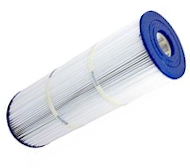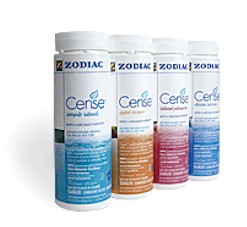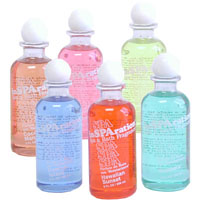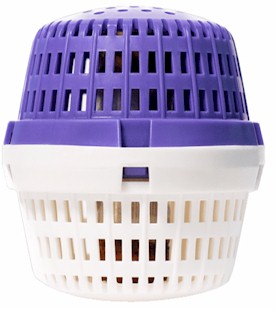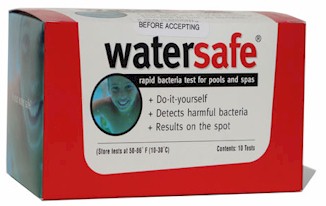|
|
269-978-1983
|
| |
|
|
|
|
|
|
|
|
|
|
|
|
|
|
Popular Products:
|
|
|
|
|
|
|
|
|
|
|
| |
|
Swimming Pool and Hot Tub Water:Fixing high or low pH and Total Alkalinity
Now it's time to tackle the big one... pH and total alkalinity. Maintaining these levels is perhaps the most important - but also the most confusing - aspect of spa and pool maintenance. When laid out in a few simple steps, however, the matter becomes much less daunting. Here's what you need to know:
- For clear and comfortable water, your pH needs to be between 7.2 and 7.6.
- The total alkalinity controls how easy or hard it is for you to adjust your pH levels.
- If your total alkalinity is too high, your pH level will be almost impossible to change.
- If your total alkalinity is too low, your pH will be very volatile.
- The total alkalinity should be between 60 and 120 PPM (PPM = parts per million).
What is pH?
pH indicates how acidic or alkaline your spa water is. A pH reading below 7 is considered acidic, and a pH reading above 8 is alkaline. pH is the most important element of water maintenance, as chlorine is only completely effective if the pH is in the appropriate range (between 7.2 and 7.6).
Low pH can result in the following problems:
- Poor sanitizer efficiency
- Corrosion of metal parts (heaters, steps, other equipment)
- Eroding of the pool plaster or grouting
- Staining of the spa shell or pool surface
- Burning eyes/nose
- Itchy skin
- Destruction of total alkalinity
- Fading of swimwear, pool toys, etc.
High pH can result in the following problems:
- Poor sanitizer efficiency - leading to algae growth
- Scale or calcium formation
- The need for frequent filter cleaning due to filter clogging
- Burning eyes/nose
- Itchy skin
- Dull or cloudy water
What is total alkalinity?
Total alkalinity is the measure of all the alkaline material in the water, and in essence, lets us know the water's ability to resist changes in pH. If the total alkalinity is too high, your pH level will be almost impossible to change. If total alkalinity is too low, your pH will bounce all over and will be very hard to control or maintain.
Low total Alkalinity can result in the following problems:
- Corrosion of metal parts (hearters, steps, other equipment)
- Etching of the plaster, marcite, marbelite, or grouting
- Staining of the spa shell or pool surface
- Rapid fluctuations in pH
- Burning eyes/nose
- Itchy skin
- Green water
High total alkalinity can result in the following problems:
- Poor sanitizer efficiency - leading to algae growth
- Stagnant pH levels
- Scale or calcium formation
- Burning eyes/nose
- Itchy skin
- Cloudy water
How to Test and Fix pH and Total Alkalinity Problems
The first step is to check your total Alkalinity and pH levels. This can be done using the AquaChek Tru-Test Digital Test Strips Reader - a quick and simple way to get accurate measurements of pH, total alkalinity, and calcium hardness. Now, use can your results to find your corresponding solution in the table below. First locate your total alkalinity level on the table, and then from there, locate your ph level.
For reference:
- RED indicates a level that is too high
- GREEN indicates a normal level
- BLUE indicates a level that is too low
|
|
TOTAL PH |
| Low (Below 7.2) |
Normal (7.2 - 7.6) |
High (Above 7.6) |
T
O
T
A
L
A
L
K
A
L
I
N
I
T
Y |
LOW
Total
Alkalinity
Below
60 PPM |
Add Sea Klear pH Increaser to your water to raise both pH and total Alkalinity.
If need be, add Pool Solutions Total Alkalinity Increase to further increase the total alkalinity.
|
Add Pool Solutions Total Alkalinity Increase to your spa or pool to increase the total alkalinity without affecting your pH.
|
Spa: Treat with regular doses of Sea Klear pH Reducer
Pool: Trea with regular doses of Pool Solutions pH Decrease.
Spa and Pool: Then use Pool Solutions Total Alkalinity Increase to increase the total alkalinity without further affecting your pH.
|
NORMAL
Total
Alkalinity
between
60 PPM
and
120 PPM |
Treat your spa or pool with soda ash - this will raise your pH without also raising the total Alkalinity.
|
Enjoy Your Pool or Spa! |
Spa: Treat with regular doses of Sea Klear pH Reducer
Pool: Treat with regular doses of Pool Solutions pH Decrease.
Spa and Pool: If your total alkalinity falls below the appropriate range, add Pool Solutions Total Alkalinity Increase to bring it back up.
|
HIGH
Total
Alkalinity
Above
120 PPM |
Spa: Treat with regular doses of Sea Klear pH Reducer
Pool: Treat with regular doses of Pool Solutions pH Decrease, but do NOT use the steps utilized to the far right in this table, as this would be too intense for the problem, and could potentially drop your pH levels to even lower levels, causing additional problems.
Spa and Pool: To raise the pH, add soda ash, which will raise your pH without also raising the total alkalinity.
|
Spa: Treat with regular doses of Sea Klear pH Reducer
Pool: Treat with regular doses of Pool Solutions pH Decrease, but do NOT use the steps utilized to the right in this table, as this would be too intense for the problem, and could potentially drop your pH levels to low levels, causing additional problems.
Spa and Pool: If you pH does drop, add soda ash, which will raise your pH without also raising the total alkalinity.
|
Spa: Treat with regular doses of Sea Klear pH Reducer
Pool: Treatwith regular doses of Pool Solutions pH Decrease. follow these steps below:
- Turn off the jets or pumps so that the water can settle.
- Pour the pH decreaser into the spa, or into the deep end of the pool, and let it sit for 5 minutes in spas or 20 minutes in pools. Bubbles indicate the elimination of the extra alkalinity). *You should dilute the pH reducer in a bucket of water prior to adding it to the water you are treating, in order to prevent etching and the weakening of your spa shell or pool surface.
- Turn the jets or pumps back on so that the solution can spread.
|
Once all adjustments have been made, you can secure your pH by adding Sea Klear pH Steady, which should keep your pH levels locked for three months.
*pH holding products should not be used if your calcium hardness is above 500 PPM.
|
|

